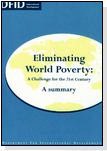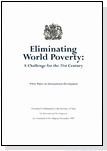|
Sustainable
Livelihoods Objectives
The sustainable
livelihoods approach is broad and encompassing. It can, however, be
distilled to six core objectives. DFID aims to increase the sustainability
of poor people’s livelihoods through promoting:
-
improved access
to high-quality education, information, technologies and training
and better
-
nutrition and
health;
-
a more supportive
and cohesive social environment;
-
more secure
access to, and better management of, natural resources;
-
better access
to basic and facilitating infrastructure;
-
more secure
access to financial resources; and
-
a policy and
institutional environment that supports multiple livelihood strategies
and promotes equitable access to competitive markets for all.
Key Concepts
The livelihoods
approach is necessarily flexible in application, but this does not mean
that its core principles should be compromised. This sheet outlines
these principles and explains why they make such an important contribution
to the overall value of the approach.
People-centred.
The livelihoods
approach puts people at the centre of development. This focus on people
is equally important at higher levels (when thinking about the achievement
of objectives such as poverty reduction, economic reform or sustainable
development) as it is at the micro or community level (where in many
cases it is already well entrenched).
People – rather
than the resources they use or the governments that serve them – are
the priority concern. Adhering to this principle may well translate
into providing support to resource management or good governance (for
example). But it is the underlying motivation of supporting people’s
livelihoods that should determine the shape of the support and provide
the basis for evaluating its success.
Holistic
The livelihoods
approach attempts to identify the most pressing constraints faced by,
and promising opportunities open to, people regardless of where (i.e.
in which sector, geographical space or level, from the local through
to the international) these occur. It builds upon people’s own definitions
of these constraints and opportunities and, where feasible, it then
supports people to address/realise them. The livelihoods framework helps
to ‘organise’ the various factors which constrain or provide opportunities
and to show how these relate to each other. It is not intended to be
an exact model of the way the world is, nor does it mean to suggest
that stakeholders themselves necessarily adopt a systemic approach to
problem solving. Rather, it aspires to provide a way of thinking about
livelihoods that is manageable and that helps improve development effectiveness.
Dynamic
Just as people’s
livelihoods and the institutions that shape them are highly dynamic,
so is this approach. It seeks to understand and learn from change so
that it can support positive patterns of change and help mitigate negative
patterns. It explicitly recognises the effects on livelihoods of external
shocks and more predictable, but not necessarily less damaging, trends.
Attempting to capture and build upon such livelihood dynamism significantly
increases the scope of livelihood analysis. It calls for ongoing investigation
and an effort to uncover the nature of complex, two-way cause and effect
relationships and iterative chains of events.
Building on Strengths
An important principle
of this approach is that it starts with an analysis of strengths, rather
than needs. This does not mean that it places undue focus on the better
endowed members of the community. Rather, it implies a recognition of
everyone’s inherent potential, whether this derives from their strong
social networks, their access to physical resources and infrastructure,
their ability to influence core institutions or any other factor that
has poverty-reducing potential. In ‘livelihoods focused’ development
efforts, a key objective will be to remove the constraints to the realisation
of potential. Thus people will be assisted to become more robust, stronger
and better able to achieve their own objectives.
Macro-Micro Links
Development activity
tends to focus at either the macro or the micro level. The livelihoods
approach attempts to bridge this gap, emphasising the importance of
macro level policy and institutions to the livelihood options of communities
and individuals. It also stresses the need for higher level policy development
and planning to be informed by lessons learnt and insights gained at
the local level. This will simultaneously give local people a stake
in policy and increase overall effectiveness. It is, though, a difficult
task to achieve.
.
Sustainability
While it is common
to hear and use the short-hand ‘livelihoods approach’ (i.e. omitting
‘sustainable’), the notion of sustainability is key to this approach.
It should not be ignored or marginalised.
 Return to Top of Page
Return to Top of Page
Guidance
Sheets
The Guidance Sheets
are one product of a lengthy and still ongoing process of consultation
about sustainable livelihoods. The consultation, which commenced in
January 1998, has extended to:
The process of consultation
and collaboration has been highly productive. These Guidance Sheets
are a genuinely
joint product; they try to capture thinking from well beyond DFID itself.
However, thus far, DFID’s
developing country partners – policy-makers, leaders and clients – have
not been adequately involved;
their views have been sought only indirectly. These sheets can therefore
be thought of as a starting
point from which DFID personnel, and others who find the sheets useful,
can begin to explore and
develop further the new ideas with partner organisations.
 Introduction
Introduction  Framework
Framework
 Return to Top of Page
Return to Top of Page
The
White Paper
This White Paper
sets out the Government's policies to achieve the sustainable development
of this planet. It is first, and most importantly, about the single
greatest challenge which the world faces , eliminating poverty. It is
about ensuring that the poorest people in the world benefit as we move
towards a new global society. It is about creating partnerships with
developing countries and their peoples, on the basis of specific and
achievable targets, to bring that about.
 Summary Summary    Full Text
Full Text
 Return to Top of Page
Return to Top of Page
Background
to the Debate
The background to
the livelihoods debate and how the new approaches fit into government
and non-government frameworks for supporting and targetting rural development
to the poor is discussed in "Approaches to Sustainable Livelihoods for
the Rural Poor". This document also deals with conceptual problems that
have arisen.
 |
Approaches
to Sustainable Livelihoods for the Rural Poor; Carney, D (1999),
ODI Poverty Briefing, ODI London |
 Return to Top of Page
Return to Top of Page
|





